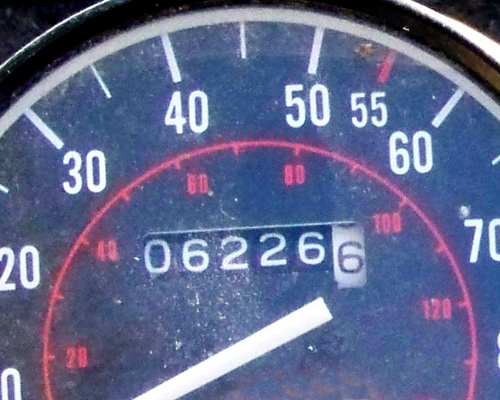I mentioned the gas cap issues in my previous post. Well, here’s what I did: I took some of my excess vacuum hose, slit it open lengthwise, filled it with some strong contact cement, then put it over the slot (trough?) that the gas cap seal is supposed to fit into. I spread a little motor oil on the tank itself so the cap wouldn’t stick to it, then put the glued cap back on the bike. The idea was to hold the rubber hose in position until the glue set up.
It mostly worked. Unfortunately, a little bit of the glue made contact with the tank, and ate a couple of small spots of paint. Fortunately the damage is hidden under the cap, but it does irritate me that I didn’t foresee the possibility.
Sadly, however, it only partly fixed the problem. I know the cap was leaky because I could see gasoline vapor coming out and condensing on the tank with the cap in place; but, even with the new seal, it still smells of gasoline rather strongly.
Then I made another discovery, accidentally. I put the kickstand down in a slightly uneven parking spot; it didn’t go down right, and I dropped the bike (in slow motion… I was doing my best to stop it, but I just couldn’t). When I picked it back up, there was a spot of gasoline on the pavement.
I put two and two together and figured out that there must be a bad hose in among the carbs. Probably one of those float bowl vent hoses. I haven’t checked it out yet, but I have replacement hose on hand to fix it, hopefully soon. For the moment, I’ve been turning off the petcock when the bike is parked, and that solves the stinky gas problem.
While trying (and failing) to see where the leak is, I noticed some of the carb drain hoses were off their nipples. So of course, I tried putting them back on, but they just cracked. The hose is a different size than the hose I have on hand, necessitating a trip to the auto parts dealer. That, too, is a repair I haven’t done yet, but will get to soon.
If you have read all of the above, by now you understand the title of this post. But wait, there’s more.
To date I’ve put 650 miles on the bike, including maybe 50 on the Interstate at 65 MPH. Imagine my expression when I realized the previous owner never replaced the tires.
I was doing all that riding on thirty-six year old Cheng Shin tires. Egad.
I did the only sensible thing… I parked the bike and set out to order tires. Finding tires that would work on the CB650 was surprisingly hard. None of the lower-priced brands could provide both a front and rear tire that would work. I’m a bit of a Shinko fan, having run their tires on my Yamaha TW200 (in front, obviously, since there are almost no tires for the back of that bike besides the Bridgestone OEM tires), but they didn’t have a tube-type rear that I thought I could work with.
I jumped into a thread on the CB650 forum in hopes of getting some help. The original Cheng Shin tires were a 100/90-19 front and a 120/90-17 rear. I have the 1979 shop manual, and it prescribes 3.50H19 in front and 4.50H17 in back; a quick Google search led me to the Motorcycle Tire School section of Maxxis’ website, which informed me that the front tire converts to 100/90-19, and the rear converts to 110/90-17 or 120/90-17. Obviously, this is consistent with what came on the bike… so far, so good.
The 100/90-19 front was easy to find in a number of brands and styles, but the 120/90-17 was surprisingly rare (remembering that I was looking for a “TT” tube-type tire). Like, non-existent. So I had to do something different.
The 120/90 tire would be 108mm tall. A 130/80 tire would be 104mm tall… pretty close, and just 10mm wider (so losing 5mm of clearance on each side). I used Bike Bandit’s sizing tool to search for that size, and found three dual-sport tires and the Bridgestone Battlax BT45. Looking at the listing, I discovered that the only tube-type tire in the rear tire section was the 130/80-17… all the rest are tubeless. Lucky, right? But the darn thing was $132.95… ack. I like Bike Bandit, but hey, I’m cheap, so I kept looking.
Amazon.com, it turned out, had that tire for $103.00 with Prime shipping, which sounded pretty good to me, but did not have the front at the same discount (nor with Prime shipping at all). Sometimes Amazon is very strange. I put the $103.00 tire in my cart and went looking at other sites.
Now, I do business with Dennis Kirk regularly, but somehow had not searched for the Battlax tires there. Imagine my surprise when I found that I could get the 130/80-17 rear for $95.88 and the front for $93.88! I threw a couple of heavy duty IRC tubes and some Kenda rim strips into the cart (why doesn’t IRC have rim strips? Seems strange to me) and submitted the order.
Last night I put the tires on. It was a good time to try out my new Harbor Freight balancing stand, and it worked quite well. The front needed a single 10g weight, while the rear needed nothing (yeah, I didn’t believe it either, stood there spinning the tire over and over like I had some sort of neurological issue).
So. Progress. Still have some problems to beat with rubber hoses, but at least now I’m not afraid to ride it.
Part 2 coming soon… as in, whenever I fix those remaining hoses.











